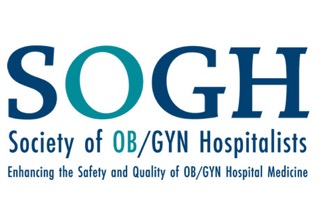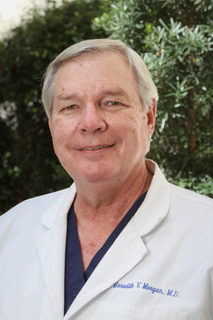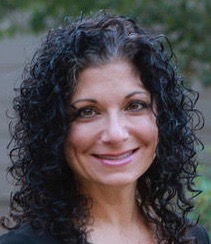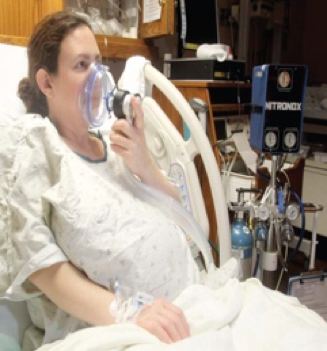SOGH March 2017 NewsletterSOGH is dedicated to enhancing the safety and quality of OB/GYN Hospital Medicine by promoting excellence through education, coordination of hospital teams, and collaboration with healthcare delivery systems. This Newsletter Sponsored by Cervidil
PRESIDENT'S MESSAGE
This month’s most important SOGH news relates to our Strategic Planning meeting held in late January. During a very focused two-day session involving our Board members and Executive Director, a strategic framework was created for how to serve our constituents in the most relevant ways possible. Specifics will follow in a future communication. I hope each of you is as convinced as I am that a dedicated, in-hospital care model is a better way to serve the needs of women. Along with other leading organizations, SOGH participates with the Council on Patient Safety in Women's Health Care. Insight into the already established process of "Readiness, Recognition, Response and Reporting/Review" is provided in Patient Safety Bundles from the Alliance For Innovation on Maternal Health and you can access it at: https://safehealthcareforeverywoman.org/aim-program/aim-emodules/#link_acc1-3d The Society's ACM Committee is honored to announce plans for advancing further awareness in this area with a presentation by Elliott Main, M.D. in Sepbember at our ACM. While attending historic Super Bowl LI, I wondered: What was Super Bowl VII like? Where was the NFL at age seven?; And where was SHM at age seven? As SOGH approaches its seventh year, I am proud of its accomplishments and can only envision what the organization will be at age fifty-one! On a personal note, if you should be in Houston, I would be happy to help with suggestions about local amenities. Additionally, I look forward to seeing you at our Special Interest Group Session at ACOG in San Diego in May. Best Regards, Meredith
IN THE NEWSExperience...Learn...Explore...at our ANNUAL CLINICAL MEETING 2017September 24 - 27, 2017
This year’s 7th Annual Clinical Meeting is slated to be the most comprehensive and robust in our organization’s history. Join us in New Orleans and experience hands-on simulation courses that include didactic and interactive components, training skills stations utilizing the most up-to-date techniques, as well as clinical workshops on a variety of special interest topics. Learn some of the most innovative and advanced skills, all while networking with some of the top OB/GYN hospitalists and generalists, certified nurse midwives, OB/GYN residents and healthcare professionals from across the country. This year’s workshops will include:
Mark your calendars now and watch for online registration this Spring! And, plan to come early and stay late so you will have time to explore the great city of New Orleans. Please check the Annual Conference page on the SOGH website for updates!
Trina Pagano, MD, FACOG Jane Van Dis, MD, FACOG “CODE THIS!” (Case of the Month)Placenta Only Delivery, Repair and Curettage by Lori-Lynne A. Webb, CPC and Renée Allen, MD, MHSc., FACOG Case Excerpt (summary and narrative of actual case): Comments Brief Note The OBGYN hospitalist was requested to be present and supervise the last hour of the second stage and attend the vaginal delivery of this Certified Nurse Midwife’s (CMW) patient, a 35 y/o G1P0 female at 39 6/7 week gestation. The Hospitalist was informed that variable decelerations were noted during the active phase of the labor and increased in frequency during the second stage of labor. Upon arrival into the delivery room, the OBGYN Hospitalist noted that the patient was pushing with good effort. The fetal vertex was at +2 station and straight OA. It was decided to have the patient push with every other contraction to allow for a longer recovery period between expulsive efforts. In the last 20 minutes of the second stage, the Hospitalist noted that there were variable decelerations to the 90's even between contractions. The Hospitalist discussed the option of a possible vacuum assisted delivery due to the frequent variable decelerations but the patient was reluctant to proceed with the operative delivery and instead continued her pushing efforts. The patient’s expulsive efforts were able to bring the baby to crowning at 00:22 and the CMW delivered the fetal vertex over an intact perineum at 00:25. The shoulders and body delivered very quickly thereafter. The baby was placed on the mother's abdomen but the pediatric nurse noted that he had no tone or respiratory effort so the NICU team was called immediately and the baby was taken to the warmer. The baby's HR was >100 initially but he was not making spontaneous respiratory effort. PPV was initiated after the first minute of life as the newborn’s heart rate fell to under 100 but the hospitalist and pediatric nurse had difficulty getting an adequate seal on the mask, so there was no chest rise noted. The NICU team arrived at 2.5 minutes of life and assumed care of the baby. His APGARS were 2 and 8. The newborn was subsequently taken to the NICU due to grunting . The arterial cord gas clotted but the venous pH was 7.29 with Base Excess 5.0. The placenta did not deliver spontaneously. The bulk of the placenta was in the vagina but appeared attached by an edge. The placenta was manually extracted without difficulty with trailing membranes noted. The placenta was noted to be circumvallate with a pseudoknot in the cord. A large clot followed the placenta but the uterus was firm and bleeding was minimal thereafter. A manual sweep of the uterus was performed with additional membrane fragments removed. The ultrasound was brought into the room and an ultrasound imaging performed by the OB/GYN Hospitalist demonstrated remnants of placenta still contained within the uterus. A bedside curettage was performed under ultrasound guidance with 3 passes of the curette with only a small amount of clot removed. The endometrial stripe appeared normal following the curetting measuring 0.8 to 1.4cm. Overall the procedure was very well tolerated by the patient under epidural anesthesia . IV Unasyn 3gm X once was given for postprocedure antibiotic prophylaxis. The vaginal and labia were inspected to reveal a posterior vaginal wall laceration that was just a few centimeters in length and a small left labial laceration, second degree . The vaginal laceration was repaired with a 3-0 Vicryl running, and the labial laceration was repaired with 4-0 vicryl running. Of note, the patient had a prior history of labial cosmetic surgery and has minimal labial minora and vertical scars along her bilateral labia majora.
As the OB hospitalist, how would your services be coded? Answer: ICD 10 Diagnosis Coding considerations include:
CPT codes CPT 59414 Placenta Only Delivery
CPT 59160-51 Bedside Curettage (with modifier 51)
CPT 76998-26 Bedside Ultrasound (with modifier 26 (professional component)–reading and interpretation by physician only.
CPT 59300-51 Repair Procedures for Maternity Care and Delivery (with modifier 51)
Coding Brief
The OB/GYN Hospitalist, in this case, correctly assigned the diagnosis code of O73.0 Retained Placenta without Hemorrhage and O70.1 Second Degree Perineal Laceration during Delivery after a thorough pelvic examination and ultrasonographic evaluation was performed by the Hospitalist.
The delivery of the placenta by the Hospitalist should be coded using CPT Code 59414 – Delivery of Placenta. This CPT code should only be reported when the procedure is done separately from the routine delivery:
The OBGYN Hospitalist should bill for the bedside ultrasound performed, read and interpreted by the Hospitalist using the CPT code 76998 with modifier 26.
The Hospitalist determined the patient had retained placenta that needed to be managed by curettage, of which the Hospitalist gently scrapes the endometrial lining of the uterus to control bleeding, treats obstetric lacerations, or removes any remaining placental tissue.
This procedure should be coded using CPT code 59160 Scraping of lining of uterus post-delivery CURETTAGE POSTPARTUM. Since the postpartum uterus has been previously dilated during delivery of the newborn, dilation is not required for this surgery. This code is only to be used for postpartum curettage.
The vaginal and left labial repairs performed by the Hospitalist during this case should be billed using:
It is important to discuss modifier 51 in this case scenario. Modifier 51 - Multiple procedures - should be employed to show that the same provider performed multiple procedures (other than E/M services) during the same session. List the most resource-intense (highest paying) procedure first, and append modifier 51 to the second and any subsequent procedures.
Modifier 51 indicates:
Payers usually apply a "multiple procedure discount" with modifier 51. This reduces the reimbursement for subsequent procedures because resources are shared when two or more procedures are performed together.
Lori-Lynne A. Webb, CPC, CCS-P, CCP, CHDA, COBGC and ICD10 CM/PCS Ambassador/Trainer is an E&M, and Procedure based Coding, Compliance, Data Charge entry and HIPAA Privacy specialist, with over 20 years of experience. Lori-Lynne’s coding specialty is OB/GYN office & Hospitalist Services, Maternal Fetal Medicine, OB/GYN Oncology, Urology, and general surgical coding. She can be reached via e-mail at or you can also find current coding information on her blog.
Dr. Renée Allen served co-author of this column. She is the SOGH Liaison to the ACOG Committee on Health Economics and Coding and Co-Chair of the Development Committee. She currently works as an OB/GYN Hospitalist with Mednax/Obstetrix at Eastside Medical Center in Snellville, Georgia.
Questions regarding this case? Contact us!
PRACTICE MATTERSby: Sarah Lynn Lovell Frey, MD During my third year of residency training at the University of California, Irvine, a group of new physicians joined the university and formed an OB/GYN Hospitalist division within the department of Obstetrics and Gynecology. Throughout my residency training we worked closely with all the attending physicians on the labor and delivery unit. However, this new group of physicians was unique – they specialized in hospitalist obstetrics and gynecology. In addition to benefiting from their knowledge, experience, and teaching on labor and delivery, the unit soon was benefitting directly from their unique approach through in situ simulation drills, updated hemorrhage protocols, and new safety tools developed with Perinatal TeamSTEPPS – a Lifewings Hardwired Safety Committee. While searching for my own post-residency plan, I had many insightful conversations with Dr. Jennifer Butler, the director of the OB/GYN Hospitalist Division. We discussed a myriad of career paths. During this time it also happened that the division was initiating a new fellowship program for OB/GYN hospitalists. When I heard about this fellowship opportunity I was instantly intrigued. With a focus on becoming a leader in hospitalist safety and implementation, I applied to the fellowship and was excited to be accepted as the first participant in the OB/GYN Hospitalist Fellowship at UC Irvine. The fellowship is one year in length, and provides high quality, advanced education in hospital-based obstetrics and gynecology with a focus on maximizing patient safety development of skills to become a leader in hospitalist medicine in both academic and community-based hospital settings. At Fountain Valley Regional Medical Center, a local community-based hospital, I worked alongside the OB/GYN hospitalist team on the labor and delivery ward, providing immediate emergency obstetric care to patients as needed and supporting other community OB/GYN physicians during massive hemorrhage situations. Several times per month I also worked with the perinatology physicians in the ultrasound suite, improving my ultrasound skills. I also participated in a variety of activities focused on improving safety, education, and communication on the labor unit. In the OB Quality Core Committee meeting, nurses and physicians worked alongside anesthesiologists, neonatologists, and hospital administration to address concerns on the unit ranging from induction of labor, postpartum hemorrhage rapid transfusion protocols, and streamlining antibiotic administration and a team-based approach to chorioamnionitis management. A specific project I was assigned to was an initiative to reduce the episiotomy rate on the unit through increased awareness and education of providers. Working with the incredible nursing staff in the labor unit through regular fetal heart rate tracing rounds, nursing education lectures, nursing skills day activities, and as a team in emergency situations both simulated and very real was a true highlight." At UC Irvine Medical Center, I supervised and taught resident physicians on a busy high-risk labor and delivery unit, while also providing emergency room gynecologic consultations. Throughout these shifts an OB/GYN Hospitalist attending was assigned as back-up, available for phone curbsides and to assist in person to ensure maximum patient safety in the event of an overwhelmingly busy unit. Twice per month I gained interdisciplinary knowledge and experience by joining the anesthesia team, learning to place epidural and spinal anesthesia to our laboring and cesarean section patients, evaluating patients with a post-epidural headache, and assisting with arterial line placement and blood transfusions with the anesthesia team during complicated cases of placenta accreta necessitating a cesarean hysterectomy. In addition to the incredible clinical experience, I was able to gain further gynecologic surgical experience through advanced dilation and curettage and dilation and evacuation training at Planned Parenthood, staffing resident clinic gynecologic cases, and assisting the gynecology oncology attending physicians in the operating room when needed. Most importantly, the OB Hospitalist fellowship provided me with incredible opportunities to work with wonderful nurses, scrub technicians, clerks, and physicians from a variety of disciplines to improve safety for patients and staff both on the labor and delivery unit and throughout the hospital. As a year-long research project, I worked with the OB Perinatal Simulation team to design and implement a study assessing the educational impact of multidisciplinary simulation training versus lectures in obstetric emergencies. The findings resulted in expansion of the multidisciplinary training, especially amongst the physician and nursing staff. These findings and were presented at this past year's Society of OB/GYN Hospitalists Annual Clinical Meeting and the Society for Simulation in Healthcare’s International Meeting on Simulation in Healthcare. As a member of both the Perinatal TeamSTEPPS and Quality and Safety Committee, I gained knowledge regarding the challenges facing the nursing, OB/GYN, anesthesia, and neonatal teams. I was introduced to the quality indicators by which the hospital is monitored, and I was able to contribute to implementation of a monthly multidisciplinary electronic update to facilitate communication of new recommendations and safety measures in the department. I also participated in medical education through medical student simulation lab, cadaver lab teaching, and by providing teaching lectures to medical students, OB/GYN residents, Family Medicine residents, and Surgical ICU residents, fellows, and attending physicians. Throughout the year I had the support and encouragement of five incredible OB/GYN Hospitalist attending physicians who were available and eager to discuss project ideas, answer questions, provide a sounding board on several projects, and edit more papers and IRB submissions than I ever thought possible. After completing the one-year fellowship, I have had the opportunity to apply the skills gained to my current role as a lecturer and faculty member at Busitema University Faculty of Health Sciences and Mbale Regional Referral Hospital in Mbale, Uganda through the Global Health Service Partnership, encompassing Peace Corps, SEED Global Health, and PEPFAR. Although the setting and resources are starkly different than those in the United States, with a maternal death rate of 343/100,000 births according to the United Nations Population Fund, the principles of safety remain the same. I have had the opportunity to teach medical students, interns, medical officers, and even colleagues about uterine balloon tamponade for postpartum hemorrhage, fluid management in severe pre-eclampsia and eclampsia and even taught by example the role of perimortem cesarean section during a maternal code. I am incredibly thankful to the OB/GYN Hospitalist Division and the entire UC Irvine Perinatal Team of nurses, physicians, and staff for the dedication and teaching they provided me during the year. Words cannot even begin to express my gratitude. Sarah Lynn Lovell Frey, MD FACOG CLINICAL PEARLby Brigid McCue MD, PhD No Laughing Matter: Alternative Uses of Nitrous Oxide in Labor and Delivery A 23 yo G2P1 presents to the OB ED for cerclage removal. She has a history of a 24 week delivery thought to be due to cervical insufficiency, and had a McDonald cerclage placed at 16 week gestation. An uneventful pregnancy followed, and the patient was scheduled to have the cerclage removed at 36 weeks in her obstetrician’s office. The patient was unable to tolerate removal of her cerclage and she is referred for removal under anesthesia in the OR. Due to high volume of cesarean sections and the non-emergent nature of her procedure, the patient is faced with a long wait. She consents to cerclage removal with the assistance of nitrous oxide analgesia in the OB ED. Patient is instructed as to the proper use of patient controlled nitrous oxide in a 50/50 blend. The procedure is carried out quickly with excellent patient compliance. After a period of observation the patient is discharged to home. She presents two weeks later in active labor. Nitrous oxide (N2O) is an inhaled anesthetic gas commonly used in general anesthesia and dental care. Use in labor is common in several European countries (used by 50%-75% of laboring patients in the UK), and began growing quickly in the US after re-introduction of portable, self-administered delivery devices (e.g. Nitronox or Pro-Nox). N2O has an onset of action approximately 50 seconds after inhalation and dissipates seconds after cessation of use. When used as instructed, the delivery device scavenges the exhaled N2O and prevents contamination of the environment. Contraindications are few, but include women with a baseline arterial oxygenation saturation less than 95% on room air, acute asthma, emphysema, pneumothorax, bowel obstruction or pneumocephalus (as N2O can cause expansion of closed, air-filled compartments). B12 deficiency is a relative contraindication as N2O inactivates vitamin B12, however intermittent use for a limited time is associated with minimal to no hematologic effects. Limited studies show no significant adverse neonatal effects measured by Apgar score or umbilical artery and vein blood gases 1. N2O crosses the placenta but negative effects on human fetuses exposed to N2O have not been described. In addition to the mild analgesic effect of 50% nitrous oxide, patients describe a marked anxiolytic effect which facilitates procedures in the antepartum, intra-partum and postpartum periods. Patients describe feeling a detachment and relief from anxiety, enabling increased cooperation with caregivers; “I knew I was in pain but I didn’t care”. N2O can facilitate placement of IV or spinal for the needle-phobic patient, placement of the cervical ripening balloon, repair of the difficult perineal laceration, or retrieval of a retained placenta. Nitrous oxide analgesia is an additional tool in the safety armamentarium of the ob/gyn hospitalist.
Patient self administration of nitrous oxide in labor. References: 1) Clinical trials of different concentrations of oxygen and nitrous oxide for obstetric analgesia. Report to the Medical Research Council of the Committee on Nitrous Oxide and Oxygen Analgesia in Midwifery. Br Med J. 1970;1(5698):709–713. 2) Likis FE, Andrews JC, Collins MR, et al. Nitrous oxide for the management of labor pain: a systematic review. Anesth Analg. 2014;118(1):153–167. Brigid McCue, MD, PhD, FACOGLead OB/GYN Hospitalist Ochsner Baptist Hospital 2700 Napoleon Avenue New Orleans, LA
Immediate Past President, SOGH ROUNDTABLE DISCUSSION: SOGH Annual Clinical Meeting (ACM) 2016OB/GYN hospitalists face diverse challenges. The 2016 ACM committee tackled this issue during a lunchtime networking session last year, inviting attendees to discuss and share their experiences in small group settings. Below are the highlights on one such session. GYN Challenges for the OB/GYN Hospitalists Is it necessary for the OB/GYN hospitalists to maintain their surgical skills? If so, how will you do this? For those who choose not to maintain their surgical skills, will this prove to be an obstacle in gaining hospital privileges elsewhere? These were the questions posed by attendees at the roundtable discussion. Below is a synopsis of the discussion. Most agree that the maintenance of surgical skills is important to career longevity. The biggest challenge is maintenance of gyn surgical skills. The more common gyn surgical cases performed by the OB/GYN hospitalists are surgical management of ectopic pregnancies, ovarian torsions, D&C, and ovarian cystectomies. Most participants averaged 3-4 such cases per year, total. Possible solutions to increasing gyn surgical exposure are to scrub with other obstetricians or urogyn physicians in the community. The issue of compensation or malpractice coverage for such cases was an obstacle for some. Another suggestion was the establishment of sim labs which focused on gyn surgeries. Currently, there is no benchmark for the number of cases necessary to show competency in surgical skills. It was suggested that data be collected that shows the average number of cases done by private practitioner and that the data be used as a guide to the OB/GYN hospitalists to determine a goal for the number of gyn cases necessary to maintain privileges.
OB/Gyn Hospitalist Fellowships OB/GYN Hospitalist fellowships are recent additions to the field of OB/GYN medicine. The two OB/GYN fellowship programs currently available are at Winthrop University Hospital in Mineola, NY and University of California, Irvine program. No standard currently exists for the OB/GYN hospitalists fellowships. Thus far, they are not yet ABOG certified fellowships and neither program has hit its ten year anniversary as yet. Still, the interest is expanding and the field shows promising signs of growth. During the SOGH 2016 Annual Clinical Meeting, a round table discussion was held on the topic of OB/GYN hospitalist fellowship. Present for the discussion were representative from the UC, Irvine fellowship as well as ACM attendees not affiliated with an OB/GYNhospitalist fellowship. The discussion focused on how to start a program, program structure and suitable recruits. Here is a synopsis of that discussion. In order to establish an OB/GYN hospitalist fellow program the program directors or creators will need to establish a curriculum or milestones for the participants. The UC Irvine representative shared willingness in sharing their model as a starting point. In the case of UC, Irvine, the fellowship program provides support for their other training programs such as their OB/GYN residents and CNM. The fellows also support their existing OB/GYN hospitalist program. Fellows may be recruited directly out of residency, private practice or those who are re-entering the work force following a leave. Most fellows are recruited directly out of residency The fellows through their training will be involved in rotating through ICU, perinatology and ultrasound. They along with the hospitalists are involved in hospital safety committees, establishing quality measures, policy and procedures. The hospitalists and fellows also work on establishing sim sessions and simulation labs. Fellows are involved in the training of hospital leaders and division chairs. The current work week is 50-60 hours with 12 or 24 hour shifts. To achieve cases for board certification, the fellows staff the residents’ ob/gyn clinic which generates surgical cases. In some instances, the fellows will act as an attending. Fellows may opt to perform research in their area of interest during a second year. There is some talk of creating a dual degree program such as a fellowship along with an MBA. |





